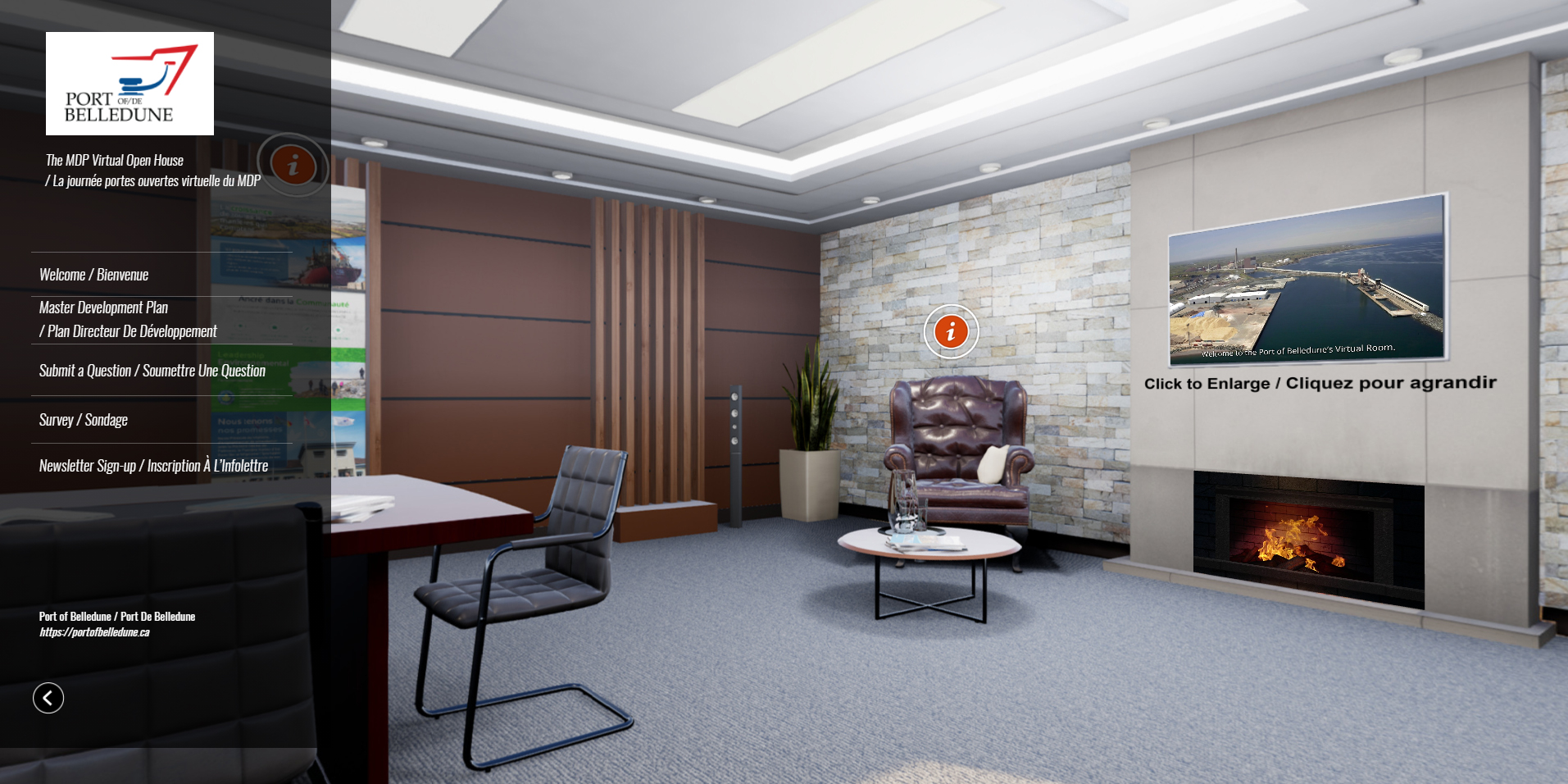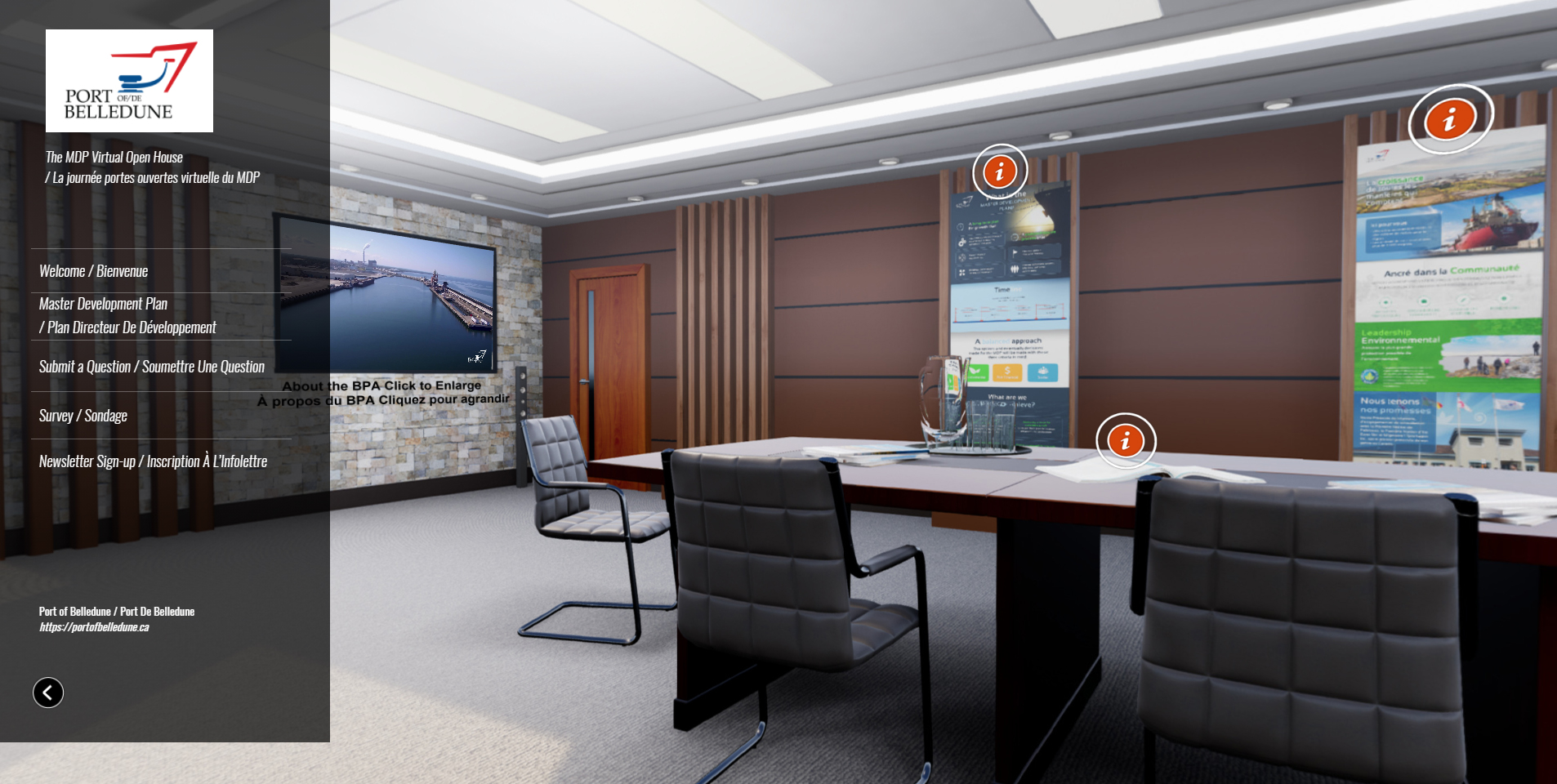The synthesis of traditional and virtual engagement: a post-pandemic future
How has the pandemic changed engagement?
As the pandemic hit, community engagement had to balance safety considerations for in-person engagement with client timelines for consultation on projects. In the case of our team’s work for the Port of Belledune, a client undergoing a master development planning (MDP) process to re-envision the New Brunswick Port for the future, creative thinking was required to ensure the client’s engagement activities remained on schedule. The solution was a group effort between Hatch’s community engagement and visualization and graphics teams. Together, they created a virtual open house environment, that allowed the Port to conduct its engagement activities remotely, inviting Indigenous communities, the public, and key stakeholders into a safe virtual environment tailored to address the project’s needs. The room contained a series of infographics, videos, and other digital materials designed to inform visitors about the MDP process and to provide multiple portals to solicit and gather feedback, including email sign-up, surveys, and even a fireside chat function designed to host Q&A sessions with Port leadership. By all accounts, stakeholders appreciated the Port’s efforts to keep them updated when so many other local activities had been put on hold. Furthermore, the virtual room can be updated easily as the Port moves through subsequent phases of the MDP process, giving communities a space to return to gain new information, ask questions, and speak to Port officials.


Both public and private sector organizations are exploring digital ways of engaging their stakeholders. Leveraging existing digital platforms has become a necessary component of the new form of virtual connection and interaction. Some of the obvious benefits of utilizing a virtual environment include cost savings, expanded outreach, and flexibility. Lower overhead costs have allowed for greater consideration and investment in enhancing the user experience, such as the creation of interactive, 3D virtual environments.
Virtual engagement offers organizations the ability to connect and build relationships with communities and groups that may have been challenging through more traditional efforts. There is flexibility in how information is shared and how individuals can access information—people are not confined to specific event hours and engagement rests on an individual’s own terms, meaning one can revisit a virtual environment when it works for them.
Virtual engagement can’t and won’t replace the importance and value of face-to-face interaction. Further, it can be challenging to achieve or maintain a valuable level of connection in a virtual space. But virtual spaces present an opportunity to rethink the collaborative experience and creating a virtual environment that brings a sense of familiarity is key in mitigating this challenge.
Make it personal
When creating virtual spaces like meeting rooms, personalization is critical. By understanding your audience, you can ensure that the space is one that individuals feel familiar or at ease with. Being able to control the environment also allows us to modify the tone, create break-out rooms that serve varying purposes, and facilitate content- and information-sharing—all while prioritizing safety through the use of technology.
The future of engagement
When it comes to public engagement, getting people to the table and maintaining a level of interest brings its own unique set of challenges. In a virtual environment, these challenges can become amplified. Additional effort is therefore required by organizations to do the necessary work to ensure users are interested and provided with the right information, making sure that the purpose is clear, and that there is a strong understanding of target audiences.
This also means giving greater consideration to the usability of the space and assuring that the virtual environment can meet the needs and experiences of a wide range of both external and internal attendees. Encouraging and maintaining dialogue virtually isn’t an easy to-do. But it can be fun. After all, these customizable spaces are intended to pique user interest.
While the value of in-person events hasn’t been lost, through the pandemic organizations have been able to pivot in creative and distinct ways to create virtual environments and events that generate connection. And though there’s desire to return to in-person interactions, the reliance on digital is and will remain prevalent going forward. Virtual engagement will continue to have a role as organizations continue to evolve their strategies for meaningful engagement.

Courtney Levesque-Thomas
Senior Specialist, Community Engagement
Courtney Levesque-Thomas is part of Hatch’s Community Engagement team as a Senior Specialist in Community Collaboration. Courtney brings with her over ten years of experience in community and Indigenous engagement, ranging from grassroots implementation to senior policy recommendations. Courtney supports Hatch’s clients through her extensive knowledge and experience in strategic communications, project planning, economic development, consultation, and community engagement.